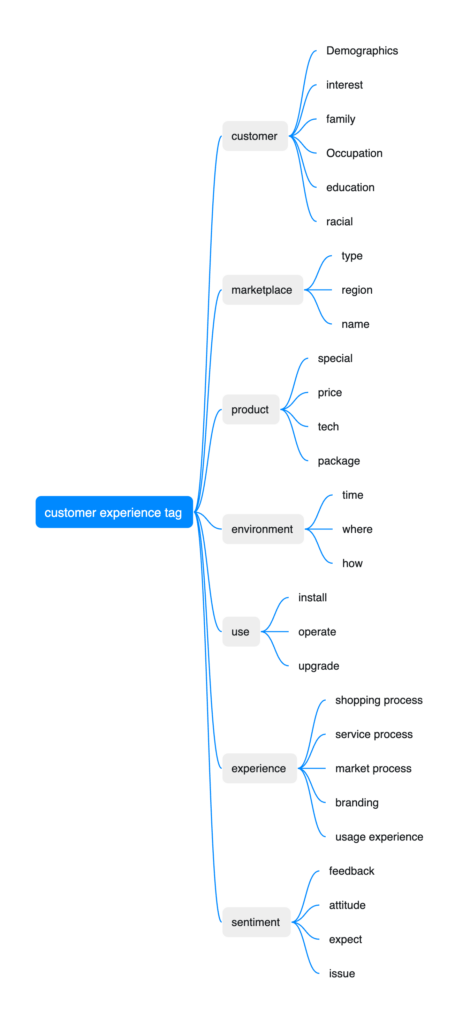What is consumer experience Tag Library
The consumer experience tag library is to design a tag library for products from the consumer's perspective, which includes the consumer's basic data, usage process, purchase process, experience and scenarios.
Different from the consumer behavior tag library and product attribute tag library, the consumer experience tag library is a tag system that combines consumer attributes, consumer actions, product attributes and consumer emotions.
The Role of consumer experience Tag Library Design
- Product: truly establish links between products, consumption scenarios, and usage scenarios. Problems, Needs and Opportunities from which to derive products
- Marketing: consumer portrait analysis and experience journey can help the marketing department find accurate customer groups and create content ideas
- Brand: Emotional feedback from consumers, consumer satisfaction and word-of-mouth can help enhance brand power, thereby increasing product premium capabilities
Approaches to consumer experience tag library design
Created by whom
In general, the product manager of the company is responsible for the design of Amazon review analysis of consumer experience tag library for his own category.
The product manager designs the consumer experience tag framework and is responsible for the tag design of product attributes in the framework. Then, five organizations including quality, market, brand, sales/operation and service are invited to expand tags. Finally, the Amazon review analysis consumer experience tag library is formed.
The product manager will formulate tag standards, quality requirements, safety requirements, maintenance mechanisms, and manage tag library iterations.
How to Create
Step 1: Determine the basic direction:
First identify objects, identify people (consumers), things (products), and relationships (use, purchase, experience, and emotion). For example: My wife thinks the appearance of this product is very beautiful. In this sentence, we can get people (wife, woman), things (appearance, ID desgin), relationships (forward, design)
Step 2: establish the design idea of Amazon review analysis:
The design idea of tags, or design logic, refers to the five ways of core words, divergence, drill-down, dynamic, and abstraction to extend the first-level and second-level tags.
Core words: if the core words are brand preferences, then subordinate tags are established around brand phrases, such as brand country, brand grade and brand grade.
Relevant: for example, around physiological parameters, we distribute all relevant tags, such as height, weight, blood type and hair color.
Drill down: The parent-child structure. Drill down all attribute tags. For example, if Bluetooth is the parent, drill down to the Bluetooth version, link technology, etc.
Dynamic: tags that record the development process and behavior process, such as browsing, clicking, sliding, and jumping out.
**Abstract: **Unified abstract processing from the same things, such as music, movies, food, tourism
Step 3: develop Amazon review analysis tag classification (level 1 and Level 2 tags)
Around the data source, we can design a primary and secondary tag tree from seven dimensions: consumer attributes, platform attributes, product attributes, environment attributes, usage attributes, experience attributes, and emotion attributes.

Step 4: compile the underlying tags for Amazon review analysis
When the primary and secondary levels are clear, we begin to continuously add, delete, modify, and query the underlying tags. Among them, the update frequency of product attribute tags is the highest, and we become the neat update, which requires the product manager to constantly gain insight into new products and sub-categories in the market and optimize the update.
How to analyze
After marking, you need to use tools to Mark and analyze the content. From the content after marking, we use tools to conduct a comprehensive Amazon review analysis.
- Consumers
Based on the product usage scenario data and the usage scenario tag heat map, the distribution of product usage scenarios under different brands of different groups is analyzed.
View the emotional distribution of consumers and identify the satisfaction degree of product functions by analyzing the scenario data of product manipulation.
Look at the pain points, cool points and demand points of consumers through the data of consumer preference expectation.
Determine product quality requirements and standards through tolerance for consumer functional quality problems - Product
mainly from the overall product quality, scene experience, function module to identify the problem - Selling Points
a comparative analysis between product selling points and consumer sentiment - Competitors
compare all the above contents with competitors' advantages and disadvantages



